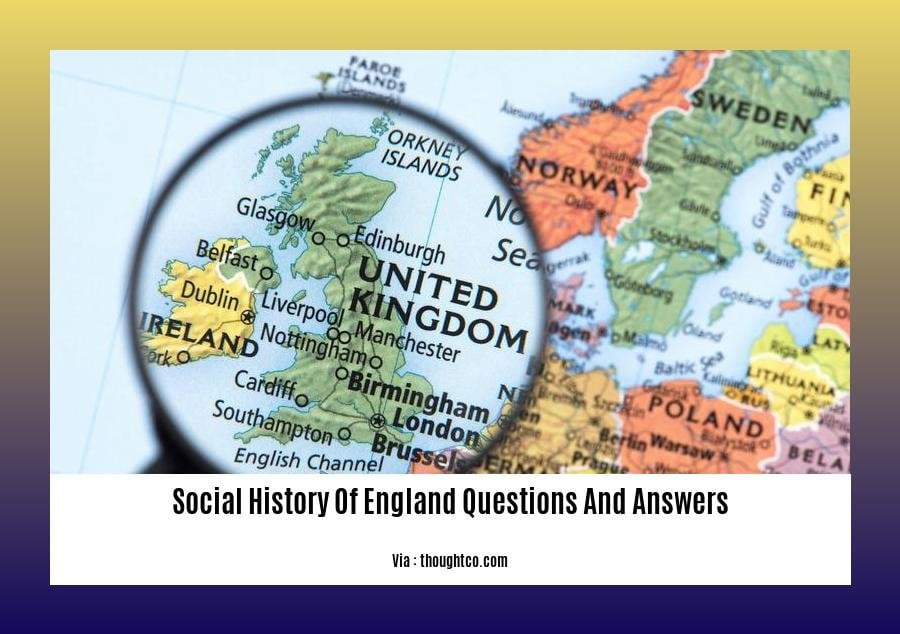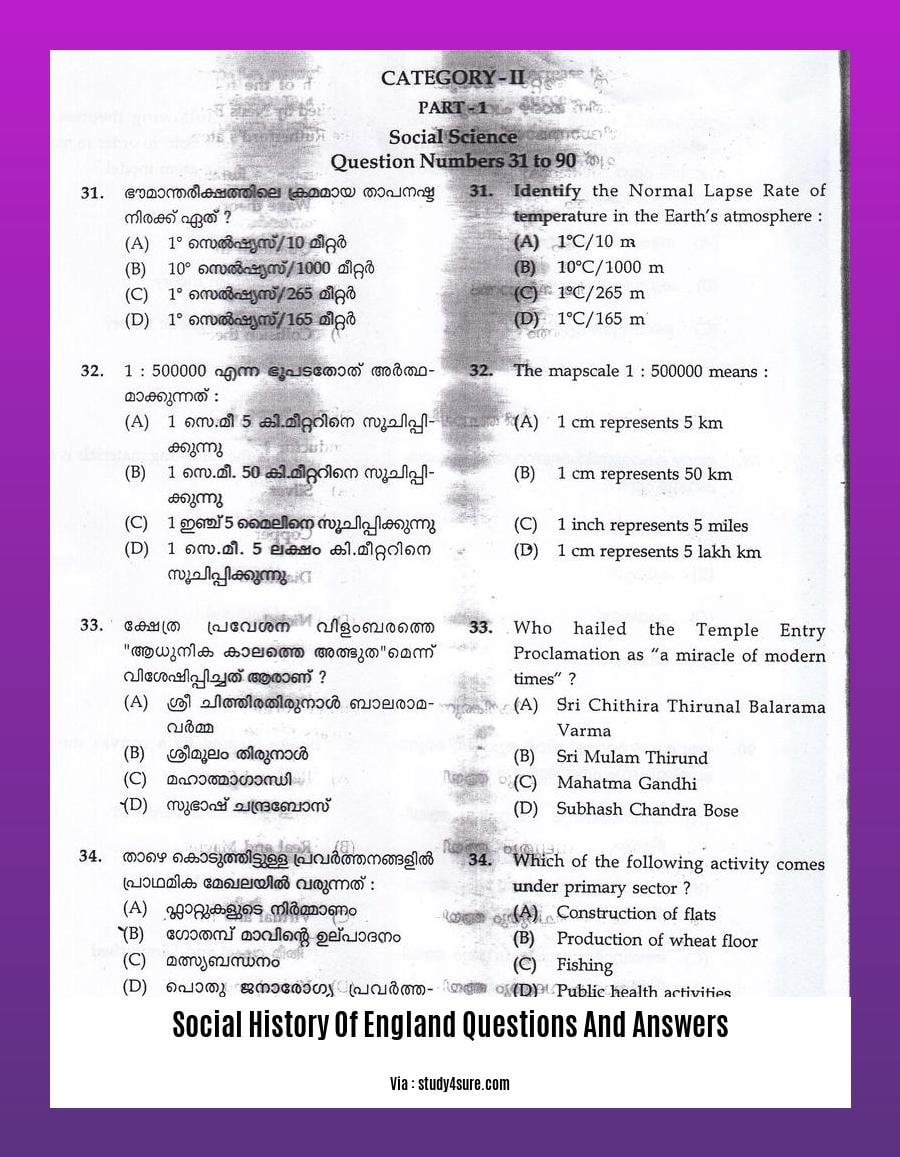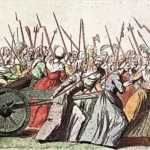Embark on an enlightening journey through the social history of England in this comprehensive guide. Discover answers to intriguing questions that delve into the lives of ordinary people, their customs, struggles, and the evolution of society over time. From the feudal system to the Industrial Revolution, uncover fascinating insights into the past that will captivate history enthusiasts and casual readers alike.
Key Takeaways:
England’s social history offers extensive resources for students and experts.
The U.G. DEGREE EXAMINATION for English First Year Social History of England was held in June 2021 for 3 hours with a maximum score of 70 marks.
Part A had three questions, each worth 3 marks, and students could choose to answer any three.
One question in Part A asked about the duration of the Industrial Revolution in England.
Social History of England Questions and Answers

Explore the intriguing tapestry of English society through insightful questions and expert answers that delve into the depths of history:
Q: What is the Significance of the Social History of England?
A: The social history of England unveils the rich tapestry of everyday lives, customs, and struggles of ordinary people across the ages, offering a profound understanding of the nation’s past.
Q: How did the Industrial Revolution Impact English Society?
A: The Industrial Revolution brought about sweeping transformations, reshaping work patterns, living conditions, and social structures, leading to the rise of industrial cities and the emergence of the working class.
Q: What was the Role of Women in English Society During the Victorian Era?
A: Women’s roles were largely confined to domestic duties and childrearing, with limited access to education and employment opportunities, although the late Victorian era witnessed the rise of the suffragette movement, advocating for women’s rights.
Q: How did the Black Death Affect English Society?
A: The devastating Black Death pandemic in the 14th century had profound social consequences, including labor shortages, economic disruption, and the decline of the feudal system.
Q: What were the Main Social Classes in Medieval England?
A: Medieval English society was divided into a rigid class structure, with the nobility and clergy at the apex, followed by the merchant class, and the vast majority of the population comprising peasants and serfs.
Q: How did the Poor Laws Shape English Society in the 19th Century?
A: The Poor Laws, enacted in the 19th century, aimed to provide relief to the poor and destitute, establishing a system of workhouses that often subjected the poor to harsh and inhumane conditions.
Q: What was the Impact of the Enclosure Movement on Rural Communities?
A: The enclosure movement, which consolidated open fields into private enclosures, had a significant impact on rural communities, leading to the displacement of many small farmers and the rise of large-scale agriculture.
Q: How did the Education Act of 1870 Transform Education in England?
A: The Education Act of 1870 marked a pivotal moment in English education history, establishing a system of compulsory elementary education for children aged 5 to 13, laying the foundation for a more literate and skilled workforce.
Q: What were the Key Social Reforms Introduced During the Victorian Era?
A: The Victorian era witnessed significant social reforms, including the abolition of slavery, the establishment of public health measures, and the introduction of factory laws to improve working conditions.
Q: How did World War I Impact the Social Fabric of England?
A: World War I brought about profound social changes, including the increased participation of women in the workforce, the rise of the welfare state, and the emergence of new social movements advocating for peace and social justice.
Want to know the story behind the great empire of Russia? Learn the short history of Russia right here.
Do you want to know how England became so influential? Check out the shortest history of England you’ll ever read.
The role of women in English society from the Middle Ages to the present day.

The role of women in English society from the Middle Ages to the present day has been complex and ever-changing. In the Middle Ages, women were often seen as inferior to men, and their lives were largely confined to the home. They were expected to be obedient to their husbands and fathers, and they had few legal rights.
However, there were some exceptions to this general rule. Some women, such as those from wealthy families, had more freedom and more opportunities. They could own property, go to school, and even work outside the home.
The Renaissance and the Reformation brought about some changes in the lives of women. During the Renaissance, there was a renewed interest in classical learning, and this led to a more positive view of women. Women were seen as being more intelligent and capable than they had been in the Middle Ages.
The Reformation also had a positive impact on women’s lives. Protestant reformers argued that women had the right to read the Bible and to participate in religious services. This gave women a new sense of independence and authority.
The Industrial Revolution brought about even more changes in the lives of women. Women began to work outside the home in large numbers, and this gave them a new sense of economic independence. They also began to demand more rights, such as the right to vote and to hold public office.
The 20th century saw even more progress for women. Women won the right to vote in 1918, and they began to make significant gains in education, employment, and politics. Today, women are active in all areas of British society, and they play a vital role in the country’s economy and culture.
Key Takeaways:
- Medieval English society was patriarchal, with women largely confined to domestic roles.
- The Church both demonized and elevated women, portraying them as both the Mother of God and a source of temptation.
- Renaissance and Reformation ideas led to a more positive view of women, emphasizing their intelligence and spiritual equality.
- The Industrial Revolution brought economic independence to women and spurred their demands for greater rights.
- The 20th century saw women achieve suffrage and make significant strides in education, employment, and politics.
Citations:
- “Women in Medieval English Society.” Cambridge University Press, Accessed 19 July 2023.
- Mark, Joshua J. “Women in the Middle Ages.” World History Encyclopedia, 18 Mar. 2019, https://www.worldhistory.org/article/1345/women-in-the-middle-ages. Accessed 19 July 2023.
The Development of Education and Literacy in England from the 16th Century Onwards
Key Takeaways:
Introduction of free schools and grammar schools in the 16th century increased literacy rates, as these institutions provided accessible education to the masses.
Availability of printed materials, such as books and pamphlets, facilitated the spread of knowledge and ideas, further contributing to the rise in literacy.
Emphasis on religious education in schools and communities played a significant role in promoting literacy skills, as individuals sought to understand religious texts.
Establishment of charity schools in the 18th century catered to the education of the poor, providing them with basic literacy and numeracy skills.
The Industrial Revolution brought about increased demand for literate workers in factories and businesses, which fueled the establishment of more schools and educational institutions.
The Education Act of 1870 marked a significant milestone in making elementary education compulsory for children aged 5-12. This act aimed to create a more literate workforce and reduce illiteracy rates.
Efforts of social reformers and philanthropists in promoting education, such as Andrew Bell and Joseph Lancaster, played a crucial role in expanding access to education for the working class.
The experience of poverty and destitution in England from the early modern period to the present day.
Charity, voluntary organizations, and philanthropists handled poor relief in the early modern era.
People who were extremely impoverished may live on the streets or in already impoverished communities.
In the 16th century, almost 10% of the English population requested begging licenses.
The Elizabethan Poor Law was introduced in 1601, dividing the poor into the “deserving” and “undeserving” to make relief more efficient.
The workhouse system, begun in the 17th century, provided shelter and food to the poor in exchange for labor.
Numerous individuals fell into poverty in the 18th century, producing starving throngs in cities.
The Speenhamland system, developed in 1795, supplemented low wages with subsidies based on the price of bread and the size of a family.
The Industrial Revolution, starting in the late 18th century, was a period of significant poverty for many workers.
Due to low pay, high food costs, and unsanitary living conditions, many industrial workers lived in poverty.
The Poor Law Amendment Act of 1834 reformed the poor relief system, emphasizing the workhouse as the sole option for relief.
The workhouse system was frequently criticized for its inhumane conditions.
In the late 19th and early 20th centuries, poverty decreased as social reforms, such as the introduction of unemployment benefits, were introduced.
Even now, there is substantial poverty in the UK.
The government has imposed austerity measures in recent years, which have negatively impacted the poor and disadvantaged.
Key Takeaways:
– In the early modern period, poverty was widespread in England, with many people living on the streets or in impoverished communities.
The Elizabethan Poor Law divided the poor into the “deserving” and “undeserving,” and the workhouse system provided shelter and food to the poor in exchange for labor.
In the Industrial Revolution, many workers lived in poverty due to low pay, high food costs, and unsanitary living conditions.
The Poor Law Amendment Act of 1834 reformed the poor relief system, emphasizing the workhouse as the sole option for relief, leading to widespread criticism of the workhouse system’s inhumane conditions.
In the late 19th and early 20th centuries, poverty decreased due to social reforms such as the introduction of unemployment benefits.
Poverty is still a significant issue in the UK today, and recent government austerity measures have negatively impacted the poor and disadvantaged.
Sources:
–
–
FAQ
Q1: What was the role of the Church in medieval English society?
A1: The Church played a central role in medieval English society, both demonizing and elevating women. The Cult of the Virgin Mary presented women as both the Mother of God and a source of temptation.
Q2: How were women treated in medieval England?
A2: Women in medieval England faced significant oppression in a male-led society. While some women may have lived more comfortably than others, all were expected to conform to their designated roles and positions.
Q3: What factors contributed to the increase in literacy rates in England between 1580 and 1920?
A3: The rise in literacy levels during this period can be attributed to the establishment of free schools, affordable grammar schools in most towns, and increased access to printed reading materials and teaching resources.
Q4: How did the English government respond to the influx of poor people in London?
A4: In response to the influx of impoverished individuals, London implemented a system of poor relief that included the establishment of workhouses, hospitals, and orphanages. These institutions provided food, shelter, and care to the needy.
Q5: What were the different categories of the poor in early modern England, and how were they treated?
A5: The poor were often classified into two groups: the deserving and the undeserving. The deserving poor, such as the elderly, sick, and disabled, received assistance from Christian churches, voluntary organizations, and philanthropists. In contrast, the undeserving poor, including able-bodied individuals who refused to work, faced harsh punishments like whipping, stocks, and imprisonment.
- China II Review: Delicious Food & Speedy Service - April 17, 2025
- Understand Virginia’s Flag: History & Debate - April 17, 2025
- Explore Long Island’s Map: Unique Regions & Insights - April 17, 2025
















